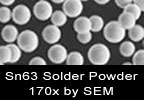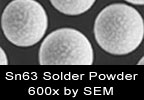| U.S.A. Tel: 630-628-8083 SHOP ONLINE |
- Visit China Facility - Visit Philippines Facility |
|



Quality solder begins with quality powder and alloys. All Qualitek soldering alloys exceed J-STD-006 and ASTM B-32 Specifications Qualitek Solder Powder Main Characteristics The trained eye of a technician often evaluates some of those properties. Others are governed by formal test procedures. For example, powder flow can be tested according to ASTM B-213, and the presence of voids can be checked by microscopic examination of cross section of individual particles. The user can identify the powder by both composition and type. Alloy composition refers to the main alloying elements; type to the range of particle (mesh) sizes. Composition The J-STD-006 (Joint Industry Standard) places requirements on the content of alloying elements. For alloys with 5% of less of an element, its content must not vary by more tan 0.2% by weight. For elements contents higher than 5% the acceptable variation from the nominal is extended to 0.5%. Because of possible deleterious effects on the solder limits also are placed on the presence of 14 impurity elements. For instance, aluminum cadmium and arsenic impurities induce dewetting, and sulfur blamed for joint grittiness. However, even when the alloy’s composition is within the industry specification small variations in elemental content can affect joint aesthetics. One joint can turn out smooth and shimmy while another will display a dull an grainy appearance. To deal with these issues, paste manufacturers often impose in-house specifications that feature strict composition tolerances. Powder Shape Particle roundness influences paste viscosity and the tendency to shear. Spheres offer less resistance to viscous flow compared with particles of irregular shape. Accordingly, paste made from the same flux and spherical powder will have lower viscosity than those of the same weight percent and particle size range but of irregular shape. One possible advantage with pastes of the latter appearance is that they are less likely to shear thin when screen/stencil printed at high speed and constant squeegee motion. Interlocking of the powder reduces paste flowout. Reduction of shear thinning is important because it will prevent slumping and smearing which can result in solder bridging and solder balling. Powder Size
|
||||||||||||||||||||||||
